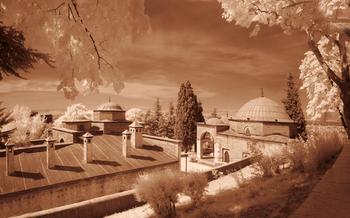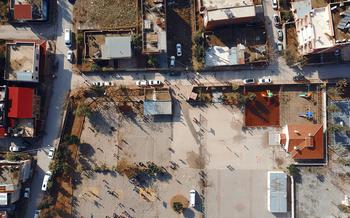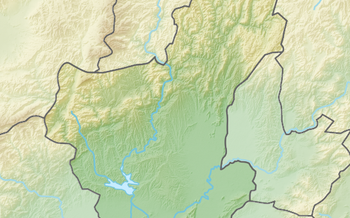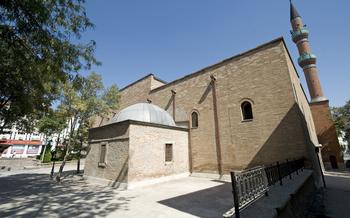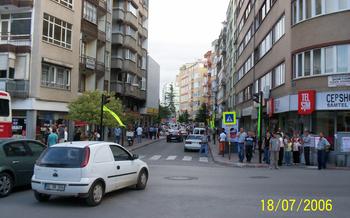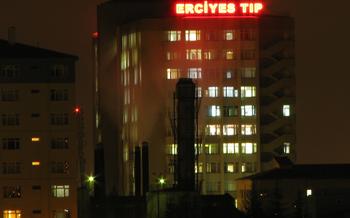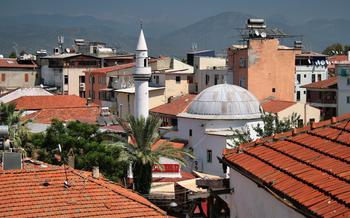
Yıldırım Bayezid Mosque
- History of the Yıldırım Bayezid Mosque:
- Location
- Architecture
- Interior
- Significance
- Visiting Hours
- Prayer Times
- Dress Code
- Etiquette: Showing Respect and Reverence
- Photography
- Guided Tours
- Accessibility:
- Nearby Attractions
- Local Crafts
- Insider Tip
History of the Yıldırım Bayezid Mosque:
The Yıldırım Bayezid Mosque, a magnificent architectural masterpiece in Kütahya, Turkey, holds a significant place in both history and Islamic architecture. Commissioned by Sultan Yıldırım Bayezid I in 1392, the mosque stands as a testament to the grandeur and devotion of the Ottoman Empire. Its construction was completed in 1402, showcasing the fusion of Seljuk and Ottoman architectural styles that characterized the period.
The mosque's unique features set it apart from its contemporaries. It boasts a spacious courtyard, a portico with intricate carvings, and an impressive dome that dominates the skyline. The interior is adorned with stunning Iznik tiles, intricate calligraphy, and a pulpit that displays exceptional craftsmanship. These elements collectively create an aura of spirituality and awe, making the Yıldırım Bayezid Mosque a must-visit destination for travelers seeking historical, cultural, and religious experiences.
Location
The Yıldırım Bayezid Mosque stands majestically in the heart of Kütahya, Turkey, a city steeped in history and cultural allure. Situated in the Old Town district, the mosque is a beacon of spirituality and architectural grandeur. Its prime location makes it easily accessible to visitors who can explore the mosque's splendor while immersing themselves in the vibrant atmosphere of the Old Town.
To reach the mosque conveniently, visitors can take advantage of the various transportation options available. The city's public transportation system provides easy access to the Old Town, with buses and trams stopping within walking distance of the mosque. Alternatively, taxis are readily available for those who prefer a direct and comfortable ride.
Once in the Old Town, visitors can enjoy a leisurely stroll through the charming cobblestone streets, admiring the historical buildings and shops that line the way. The mosque's imposing presence will guide visitors towards its entrance, inviting them to step into a realm of architectural marvels and spiritual serenity.
Architecture
The Yıldırım Bayezid Mosque stands as a testament to the fusion of Seljuk and Ottoman architectural styles. Its construction showcases the refined craftsmanship and artistic vision of the era. The mosque's design incorporates a central dome supported by four semi-domes, creating a harmonious and symmetrical composition. The exterior walls are adorned with intricate carvings and calligraphy, reflecting the artistic prowess of the builders.
The mosque's courtyard, a serene haven, features a central fountain surrounded by arched alcoves. These alcoves, known as iwans, provide shelter from the sun and offer a contemplative space for visitors to rest and reflect. The courtyard's elegant simplicity complements the grandeur of the mosque's interior, inviting a sense of tranquility and peace.
Inside the mosque, the prayer hall captivates with its vastness and exquisite ornamentation. The walls are adorned with vibrant Iznik tiles, each hand-painted with intricate floral patterns and verses from the Quran. The mihrab, the prayer niche indicating the direction of Mecca, is a masterpiece of artistry, featuring intricate tilework and a beautifully carved marble surround. The minarets, slender and graceful, soar into the sky, echoing the mosque's grandeur and serving as a call to prayer for the faithful.
Interior
The interior of the Yıldırım Bayezid Mosque is awe-inspiring, showcasing a harmonious blend of architectural elements and intricate artistry. The vast prayer hall, the heart of the mosque, exudes a sense of tranquility and devotion. The walls are adorned with mesmerizing Iznik tiles, their vibrant colors and intricate patterns creating a tapestry of Islamic art. The tiles depict verses from the Quran, geometric designs, and floral motifs, adding a touch of elegance and spirituality to the space.
One of the most striking features of the interior is the intricate calligraphy that adorns the arches, columns, and panels. Verses from the Quran and hadiths (sayings of the Prophet Muhammad) are meticulously inscribed in elegant Arabic script, adding to the mosque's religious significance. The use of calligraphy not only enhances the mosque's aesthetic appeal but also serves as a reminder of the importance of the written word in Islamic tradition.
Significance
The Yıldırım Bayezid Mosque holds immense significance not only as a religious landmark but also as a cultural symbol of Kütahya. It is a testament to the city's rich history and reflects the amalgamation of Seljuk and Ottoman architectural influences. The mosque is deeply revered by the local community and serves as a gathering place for Muslims to perform their daily prayers and celebrate religious festivals. Its presence has shaped the cultural identity of Kütahya and continues to be a source of pride for its citizens.
Beyond its religious significance, the mosque has become a symbol of Kütahya's architectural heritage. Its intricate design and impressive scale attract visitors from across the region who come to admire its beauty and learn about its history. The mosque's presence has contributed to the city's reputation as a cultural and historical destination, attracting tourists who are eager to explore its many treasures.
Visiting Hours
The Yıldırım Bayezid Mosque welcomes visitors throughout the day, reflecting its role as a place of worship and cultural significance. To ensure a peaceful and respectful environment for both worshippers and visitors, it adheres to specific visiting hours. The mosque opens its doors to the public daily, with the exception of Fridays, when it remains closed during the weekly congregational prayer.
The mosque's opening hours are generally from 9:00 AM to 5:00 PM, accommodating visitors who wish to explore its architectural beauty, intricate details, and spiritual atmosphere. It's recommended to visit during the early morning or late afternoon to avoid crowds and capture the mosque's serene ambiance.
During these designated hours, visitors are free to roam the mosque's premises, admire its architectural features, and take photographs. However, it's crucial to maintain a respectful demeanor and avoid disturbing worshippers engaged in prayer. Visitors are encouraged to dress modestly and observe the mosque's etiquette guidelines to ensure a harmonious and enriching experience for all.
Prayer Times
The Yıldırım Bayezid Mosque, like all mosques, adheres to specific prayer times throughout the day. These prayer times, known as Salat, hold great significance for Muslims and are observed with devotion. For non-Muslim visitors, understanding these prayer times is essential to show respect and maintain the sanctity of the mosque.
Prayer times in the Yıldırım Bayezid Mosque typically follow the standard Islamic prayer schedule:
- Fajr: This is the pre-dawn prayer, usually performed around sunrise.
- Dhuhr: The midday prayer, observed around noon.
- Asr: The afternoon prayer, which takes place in the late afternoon.
- Maghrib: The sunset prayer, performed immediately after sunset.
- Isha: The night prayer, observed around nightfall.
During prayer times, the mosque's atmosphere transforms into a serene and spiritual space. Visitors are welcome to observe the prayers from a respectful distance, taking care not to disturb the worshippers. For non-Muslims interested in participating in the prayers, it is advisable to seek guidance from a local Muslim or a knowledgeable guide.
Participating in the prayers can be a profound and enriching experience, offering a glimpse into the Islamic faith and its practices. However, it is important to approach this opportunity with respect and humility, ensuring that one's presence does not disrupt the spiritual atmosphere of the mosque.
Dress Code
Visitors to the Yıldırım Bayezid Mosque are expected to dress respectfully, adhering to certain dress code guidelines. Men are advised to wear long pants and shirts that cover their shoulders, while women are expected to dress modestly and cover their hair with a headscarf or scarf. Loose, comfortable clothing is recommended, as visitors may be required to remove their shoes before entering the prayer hall. It is important to be mindful of cultural sensitivities and dress appropriately to show respect for the mosque's sanctity and religious significance.
Etiquette: Showing Respect and Reverence
When entering the Yıldırım Bayezid Mosque, visitors are expected to adhere to certain rules of etiquette to honor its religious significance and maintain a respectful atmosphere. First and foremost, maintaining silence and avoiding loud conversations is essential. Keep your voice low and refrain from engaging in noisy discussions that may disrupt the tranquility of the mosque. Additionally, it is customary to remove your shoes before stepping onto the mosque's carpeted prayer area. This practice signifies purity and respect for the sacred space. Furthermore, visitors should be mindful of their body language and avoid pointing their feet towards the qibla, which is the direction Muslims face during prayers. These simple gestures demonstrate respect for the religious customs and traditions of the mosque.
Photography
Photography enthusiasts will find the Yıldırım Bayezid Mosque a treasure trove of captivating shots. While capturing the grandeur of the mosque's exterior is a must, don't miss the intricate details within. The stunning Iznik tiles adorning the walls and the intricate calligraphy gracing the mihrab make for captivating subjects.
To ensure a respectful photography experience, be mindful of the designated areas where photography is allowed. Avoid using flash or tripods that might disturb other visitors or disrupt the serene atmosphere of the mosque. Instead, embrace natural light and capture the mosque's beauty through the play of shadows and light.
For those seeking a unique perspective, consider visiting the mosque during the golden hours of sunrise or sunset. The warm hues of the sky cast a magical glow on the mosque, creating a breathtaking backdrop for your photographs. Remember to be patient and wait for the perfect moment when the light illuminates the mosque's features in the most flattering way.
Guided Tours
Guided tours of the Yıldırım Bayezid Mosque are available for visitors who want a more in-depth understanding of its history, architecture, and significance. Guided tours are offered in various languages, including English, and typically cost a small fee. The tours are led by knowledgeable guides who provide detailed information about the mosque's construction, unique features, and role in the history of Kütahya. They also answer questions and share interesting anecdotes and insights.
Booking a guided tour is a great way to make the most of your visit to the Yıldırım Bayezid Mosque. The guides not only provide factual information but also bring the mosque's story to life with their passion and expertise. They can point out hidden details, explain the symbolism behind the architecture, and share stories about the people who built and used the mosque throughout the centuries.
Accessibility:
The Yıldırım Bayezid Mosque strives to ensure accessibility for visitors with disabilities. There are wheelchair ramps and elevators available to facilitate easy movement throughout the mosque. The staff is friendly and accommodating, ready to assist visitors with special needs. If you require any assistance, don't hesitate to reach out to one of the mosque's personnel. They will gladly provide support to make your visit as comfortable and enjoyable as possible.
Nearby Attractions
After exploring the Yıldırım Bayezid Mosque, you can immerse yourself in the rich history and vibrant culture of Kütahya by visiting other nearby attractions. The city is home to several significant historical sites, including the Kütahya Castle, a formidable fortress that once served as a strategic defense outpost. The castle offers breathtaking panoramic views of the city and the surrounding countryside, making it a must-visit for history buffs and nature enthusiasts alike.
For a taste of local culinary delights, venture into the Old Town, where you'll find an array of traditional Turkish restaurants and cafes. Indulge in mouthwatering dishes like "mantı," delicate dumplings served with yogurt and garlic sauce, or savor the flavors of "pide," a delicious Turkish flatbread topped with various fillings.
If you're interested in shopping, Kütahya is renowned for its exquisite ceramics and pottery. Visit the local bazaars or handicraft shops to find a treasure trove of handmade ceramics, tiles, and other decorative items. These intricate works of art make for unique souvenirs and gifts that will remind you of your time in Kütahya.
To create a well-rounded itinerary, consider combining your visit to the Yıldırım Bayezid Mosque with other attractions in the city. Plan a day trip to explore the nearby historical sites, indulge in local delicacies, and shop for authentic Turkish handicrafts. This immersive experience will leave you with lasting memories of Kütahya's rich cultural heritage and warm hospitality.
Local Crafts
Kütahya is renowned for its vibrant and diverse range of traditional crafts, making it a hub for artisans and craft enthusiasts. Visitors can immerse themselves in the artistry of pottery, tile making, and carpet weaving, which have been passed down through generations in the city. Workshops and demonstrations offer a unique opportunity to witness the intricate techniques and creativity involved in these crafts.
For those interested in pottery, the "Germiyan" style, known for its distinctive blue and white motifs, is a must-see. Visitors can explore the pottery workshops in the city center and try their hand at creating their own ceramic masterpieces.
Kütahya tiles, with their vibrant colors and intricate patterns, are another highlight. Workshops offer hands-on experiences, allowing visitors to create their own unique tiles using traditional techniques.
Finally, carpet weaving is an art form deeply rooted in Kütahya's culture. Visitors can visit carpet workshops to witness the skillful artisans at work, creating beautiful and intricate carpets using traditional methods.
Insider Tip
One fascinating aspect of Kütahya that I discovered during my visit was the local tradition of pottery and tile making. The city is renowned for its intricate ceramic art, and visitors can immerse themselves in this rich heritage by visiting the nearby Çini Museum. The museum showcases a stunning collection of ceramic tiles and pottery, offering a glimpse into the history and evolution of this traditional craft. I highly recommend taking the time to explore this cultural treasure, as it provides a unique insight into the local artistry and craftsmanship that make Kütahya so special.
